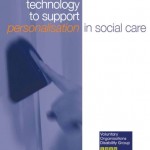
We have posted before about the use of assistive technology and in particular telecare. This week sees the publication of a new report from the Voluntary Organisations Disability Group (VODG) and the National Care Forum (NCF) which describes a number of projects which offer technological solutions to enhance personalisation.
The Department of Health has defined three of the common terms used in assistive technology
- Telehealth – concerned with remote patient monitoring, for example using point of- care technologies to monitor a patient’s physiological status and health conditions.
- Telecare – concerned with helping vulnerable people to live independently in their own homes and involves the use of sensors with 24 hour monitoring and response
- Assistive – or personalised – technology – which refers to the use of personalised equipment to meet daily needsand can include mobile technology and communication aids.
Here at Elf towers, we wanted to draw your attention to a couple of the projects in the report which feature support to people with learning disabilities.
Firstly, Hft’s virtual Smart House, which shows many of the assistive or personalised technologies available. There is a fingerprint recognition system that allows entry to the house, and a voice prompt and door sensor to others in the house of any new arrival. There is also a *bogus caller alarm’ linked to a call centre which can be used to alert supporters of any unauthorised visitors..
There are a number of features in the house which are concerned with safety, for example a kettle which shuts off automatically after use, voice prompts from the fridge to help people avoid foods they are allergic to, or bath-plugs which change colour if the water is too hot and flood sensors which shut off taps.
One person supported by HfT and using personalised technology has limited communication skills, epilepsy and is prone to falling. She moved from registered care to supported living some time ago and uses a combination of sensors, pagers and a finger print lock to get into her room, and telecare sensors overnight which are linked to a staff pager. HfT see personalised technology as part of an
on-going process of continually evaluating people’s needs and ambitions and helping people to use the abilities they have to live the lives they want. (see http://www.hftsmarthouse.org.uk)
Secondly, The Brandon Trust project where each flat in a supported housing scheme has its own assistive technology “hub”, which allows tenants to release the main front door from their flat, contact staff using an integrated or remote call button and a key fob system which lets tenants who
can’t manage a key open their own doors.
One person who lives in the project is hard of hearing, so has a flashing doorbell and a device
on her phone to eliminate background noise and amplify speech as well as a vibrating pillow alarm and a flashing alarm triggered by fire and smoke, in case this person failed to hear the fire alarm.
Support staff in the project also have a centrally located technology “hub”, which enables them to receive information from sensors in the flats and informs them, via a phone, when help is needed.
The report’s authors suggest that assistive or personalised technology has a central role in modern social care, which should strive to encourage choice, control and focus on the needs of individuals.
They suggest the benefits of assistive technology include:
• increased choice, control and independence
• stretching personal, health and social care budgets to provide more support at a time of financial constraint
• use in a variety of care settings,
• freeing support staff to concentrate on other tasks
• help commissioners and providers in running cost effective services
However, they also point to some barriers to greater use of assistive technology, which include:
- Low levels of investment in many assistive technology services
- Lack of care pathway commissioning assistive technology
- Lack of awareness of assistive technology on the part of the public.
They make some recommendations for action, including:
Action for government and commissioners:
- acknowledge the benefit of assistive technology in the context of outcome-based commissioning and measurement of impact
- take a longer-term approach beyond current fiscal constraints – long term savings may be possible
- clinical commissioning groups to take stock of potential of technology among recipients of social care,
Action for providers:
- assistive technology to be part of social care workforce development
- clarify purpose of assistive technology in improving quality of life
- review views of risk and risk management and use technology to identify, manage and mitigate risks to allow people to live their lives
They conclude:
“technology is part of our modern landscape. We use it for work, leisure, at home and on the move. It makes our lives easier. People with life-long disabilities or age related conditions should share that experience, benefitting from the advantages that tailor-made technological support can bring.”
Link to full report: Using assistive technology to support personalisation in social care
